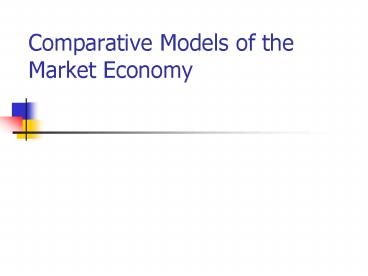Comparative Models of the Market Economy - PowerPoint PPT Presentation
1 / 22
Title:
Comparative Models of the Market Economy
Description:
Comparative Models of the Market Economy Economic problems Models of the Market Economy Market failure and social welfare function Different priorities in the social ... – PowerPoint PPT presentation
Number of Views:112
Avg rating:3.0/5.0
Title: Comparative Models of the Market Economy
1
Comparative Models of the Market Economy
2
Economic problems
3
Models of the Market Economy
- Market failure and social welfare function
- Different priorities in the social welfare
function - Three models
- The Guided Market Economy (Japan, Korea, France,
Italy, Greece, Spain, Portugal, etc.) - The Modified Market Economy (the U.S., the U.K.,
Ireland, New Zealand) - The Social Market Economy (Germany, Denmark,
Sweden, Norway, Finland, Estonia)
4
The Guided Market Economy
5
The Guided Market Economy
- Priority on resource allocation
- Direct government participation in resource
allocation and industrial restructuring - Long-term focus
6
The Guided Market Economy
- Industrial Policy
- a set of instruments and techniques designed to
promote economic growth on the basis of direct
government participation in resource allocation
and industrial restructuring - identification of key industries and promotion of
their better access to resources and faster
growth
7
Business systems
- distinctive configurations of firms and markets,
which have been established, in a particular
environment as the dominant ways of structuring
economic activities. - Characteristics of the business system
The nature of economic agents
Market organization
Work co-ordination and control
8
The Guided Market Economy
- The Business System
- A dual business structure
- Domination of big businesses
- Strong vertical and horizontal integration
- Low rate of change of activities
- Widespread subcontracting
- Small share of the medium-size firms
9
High social tension and low labor and capital
mobility
STUDENTS DEMONSTRATE AGAINST LABOR LAW French
students protest during a rally in Marseille,
France, April 11 against a measure which would
have allowed employers to fire young people under
the age of 26 without giving a reason. The
proposal was dropped by the government April 10
after large-scale protests in the country
10
The Guided Market Economy
- The Keiretsu system business groups of firms in
all industries, linked through - Interlocking directorates
- Stock cross ownership
- Financial support (provision of loans at
favorable rates) - A built-in stable market for each others
products - Transfer of labor force
- Cooperation in the international expansion
11
Main bank
12
The Guided Market Economy
- Capital markets
- The banking system serves as a major institution
of capital allocation - The main bank
- Provides debt financing
- Raises capital for the industrial firms
- Monitors
- Guarantees firms debt
- Participates in executives turnover and shifts in
corporate strategy
13
The Modified Market Economy
14
The Modified Market Economy
- Motivation for efficiency
- Main goals
- to motivate private decision makers for efficient
use of resources - to trigger higher living standards
- to moderate inequality
- to contribute to social integration
- to guarantee efficient administration
15
The Modified Market Economy
- Core institution capital markets
- The stock exchange
- High capital mobility
- High liquidity of funds
- A wide set of financial institutions
16
(No Transcript)
17
The Modified Market Economy
- The Business System
- Short term focus
- Mobile labor
- Easy hiring and firing
- High specialization of tasks, roles and skills
- High market contestability
- Strong antitrust attitude
18
The Modified Market Economy
- Welfare goals
- Free choice in consumption
- Free choice in occupation and education
- Greater purchasing power
- Widespread system of consumer credit
- Social support for the poor
- Equal opportunities to everyone
- High capital diffusion
19
The Social Market Economy
20
The Social Market Economy
- Priority on equity, social equality and full
employment - Major features
- Strong support of workable competition
- Promotion of asset formation among lower income
groups - Direct transfer payments
- Codetermination and regulation of the labor
market - Strong role of associations
- Extensive role played by local governments
- Social and welfare programs for everyone
- Faster increase in salaries than in profits
- Restrictive monetary policies
21
The Social Market Economy
- The Business System
- Prevailing medium-size firms
- Strong competition
- High owner involvement in control
- Codetermination in the big firms
- Strong associations
- Powerful cooperatives
- Dependence on the financial decisions made by the
banking sector
22
The Social Market Economy
- Capital markets
- The banking system serves as a major institution
of capital allocation - Excessive integration of the banking institutions
with the industrial enterprises in - Ownership
- Decision-making































